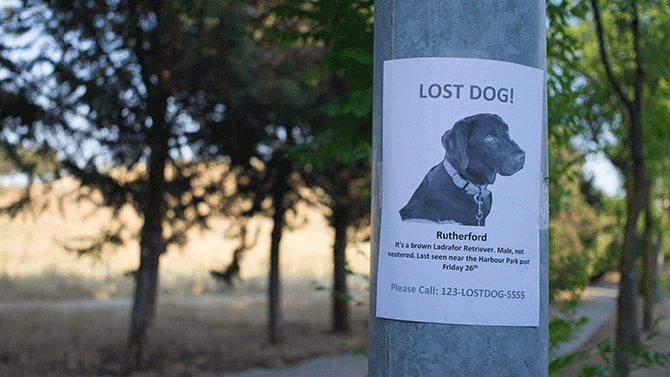It’s every pet owner’s nightmare; calling out for their faithful friend and getting no response. No clicking of paws on hardwood excitedly coming to see you, no happy panting or purring. Losing a pet can be a painful and harrowing experience, and once we’ve realised we’ve lost a pet, we might start panicking and not thinking straight. Should that unfortunate circumstance ever arise in your life, we’ve made a checklist of things you can do if you’ve lost your pet, so you can find help at a time when you may not be feeling the best. Along with a little luck, these tips will hopefully help you on your way to getting your pet back home where it belongs.
1. Check your property
Before you rush off to tell everyone you know that you’ve lost your pet, do a quick but thorough search of your property to make sure they’re not hiding, stuck, or injured somewhere you wouldn’t expect. Cats have a tendency to get locked in closets, for instance, and as the crew over at Chihuahua Rescue Victoria mention, some dogs tend to hide when feeling unwell. Always check under blankets!
Many a pet owner has panicked thinking their mutt was lost, only to remember that they’d let them out into the backyard an hour earlier. So check everywhere, but do it efficiently, because if your pet is truly lost you don’t want to waste any time in taking actions to find them.
2. Get the word out
As quickly as you can, you want to get the word out to as many people as possible. The easiest thing you can do is put a posting up online, with a picture of your pet and details including their name and any unique markings. Lots of cities and towns have local lost pets Facebook groups, and sites like Gumtree are a great way to get the information out there. Lost Pet Finders is also a great service that has a network for sharing information and getting the word out about your lost pet. The team over at Seniors and Silkies also suggests checking local Facebook groups for Lost/Found pets, as well as Buy/Swap/Sell pages.
Place flyers up around your neighbourhood, both on telephone poles and in mailboxes. Chihuahua Rescue Victoria suggests having the following information on the flyer:
- A clear photo of your pet,
- Its name,
- Simple description of the pet: breed, large/small, colour, hair length,
- Last seen date/time and location of pet, and
- Your mobile phone number.
If you find that your first flyer has had no luck, the team suggest drafting a second flyer with more details:
- A clear photo of your pet,
- Its name,
- Description of the pet: breed, large/small, colour, hair length,
- Whether they are microchipped,
- Anything noticeable about the pet, like a crazy bark or different coloured collar,
- It is also very wise to say something along the lines of "requires medication" or "needs urgent veterinary treatment". This is important because if someone has the little pet and thinks they might just keep it, they can be discouraged by the thought that the pet will cost them in veterinarian fees!
- Last seen date/time and location of pet,
- Your mobile phone number, and
- A reward if you are offering one.
Put as many of these flyers up around the area as you can. Ask shops to put the flyers in their windows. Print off smaller versions of these flyers – about A5 in size – and leave these in people’s mailboxes. Call your neighbours as well, to make sure they know your pet is missing and to let you know if they see anything. Call any veterinary offices, pet-related businesses, and shelters, and ask if you can put up flyers there as well. The more people who know about your missing family member, the better.
3. Search
You should also be conducting regular searches yourself. If your pet is frightened or injured, they may not allow themselves to be picked up by a stranger. Walk the neighbourhood with treats or other items that your animal likes, to entice them to come out of hiding. You can also place these items outside your home to encourage the dog to return. If you decide to drive through your neighbourhood, then do it slowly with the windows down, calling out every so often. You should occasionally turn the car off to listen, and because your pet might be more likely to come out from hiding if it’s quiet.
4. Visit shelters
Go to all the animal shelters in your area, every two days at the very least. There are so many pets going through these places, that you can’t be assured that a staff member or volunteer will have recognised your pet from the description. There’s also a high turnover rate in most of these shelters. Animals are brought in and either adopted out, sent to rescues, or euthanised, so you might miss your chance if you wait too long. You can also look up all the rescue agencies in your area to see if your dog has ended up with them. Doing the legwork and being proactive can make all the difference.
5. Prevention
Speaking of being proactive, it’s much better to never lose your pet at all than to have the need for a happy reunion. Regularly check your fence for any holes or damage, and make sure your gate properly latches. If you tie your pet up outside, make sure the lead is in good condition and keep an eye on your pets in case anyone wonders by who might be looking for a new furry friend.
You should also always be prepared in case of your pet getting lost. Have all of their records in a handy place to use in case you need to identify your animal. Make sure they have tags with their name and other identifying information on them. Ensure the collar contains your phone number so that you can be contacted immediately if your dog is found.
In most states it is mandatory to have your pet microchipped. If your pet is microchipped, the folks at Seniors and Silkies also suggest ringing your council to flag the microchip as missing and update the contact information on the chip. Most shelters and vet offices also have microchip scanners that can easily bring up an owner’s contact information. It’s vital that your vet has up-to-date information so they can get in touch with you if your pet has been found.
Losing a pet is frightening. Your pet is a beloved part of the family, and not knowing where they are or whether they are safe causes sleepless nights and heartbreak. If you find yourself in this unfortunate circumstance, be sure to keep yourself busy and be proactive in finding your pet.







Leave A Comment